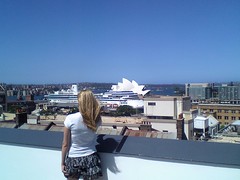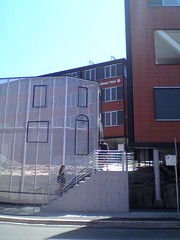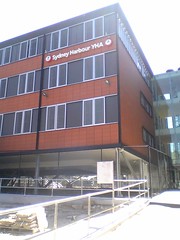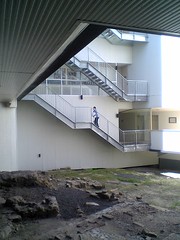Sydney Harbour Youth Hostel
 The Sydney Harbour Youth Hostel at the Rocks opened last week. I visited yesterday and was given a tour by John Bowles, YHA NSW director and met Yin Chen, General Secretary of China YHA . Do not be put off by the label "Youth Hostel"; this is accommodation to a similar standard to the best budget hotels, but with million dollar views of the Sydney Harbour Bridge and the Opera House from its rooftop terrace. If visiting Sydney you should check if there is a room at the hostel.
The Sydney Harbour Youth Hostel at the Rocks opened last week. I visited yesterday and was given a tour by John Bowles, YHA NSW director and met Yin Chen, General Secretary of China YHA . Do not be put off by the label "Youth Hostel"; this is accommodation to a similar standard to the best budget hotels, but with million dollar views of the Sydney Harbour Bridge and the Opera House from its rooftop terrace. If visiting Sydney you should check if there is a room at the hostel.
 The hostel is a project with the Sydney Harbour Foreshores authority and incorporates the Big Dig Archaeology Education Centre. The hostel building is on high columns over the remains of historical convict era building. This arrangement resembles the New Acropolis Museum in Athens. However, the YHA was built on time and mostly on budget, unlike the Athens museum which was years late and billions over budget.
The hostel is a project with the Sydney Harbour Foreshores authority and incorporates the Big Dig Archaeology Education Centre. The hostel building is on high columns over the remains of historical convict era building. This arrangement resembles the New Acropolis Museum in Athens. However, the YHA was built on time and mostly on budget, unlike the Athens museum which was years late and billions over budget.The YHA building has a steel frame and ribbed steel sheeting on some surfaces. The outer walls are clad in terracotta coloured panels, which give it an up market look. There are hard wearing by but stylish materials used, such as cork for the floors in the reception area and stainless steel kitehens. The design philosophy of the building was featured on ABC Radio "New 21st century youth hostel accommodation" (2 December 2009). The architects are Tzannes Associates. Unfortunately, like many architects, they have a very poor quality web site and I was unable to find any details of the building.

 The archaeology below and next to the building is protected by a perforated metal screen. The claim is that this has been sized and decorated to echo the terrace buildings which were on the site. To me they looked oversize and intrusive. It would be too late to change the design, but the screens could be repainted from white to a less conspicuous colour, perhaps with a photo mural of terrace houses on them.
The archaeology below and next to the building is protected by a perforated metal screen. The claim is that this has been sized and decorated to echo the terrace buildings which were on the site. To me they looked oversize and intrusive. It would be too late to change the design, but the screens could be repainted from white to a less conspicuous colour, perhaps with a photo mural of terrace houses on them.The ground floor of the building is open to the archaeology site, with walkways from the street and to the education centre, which has an exellent small meeting room which can be hired. Walking up a flight of stairs you reach the reception desk of the YHA, which also looks out onto a cyber cafe and the DIY kitchen and eating area. This is a much more open and comfortable arrangement than YHAs in converted buildings, where the kitchen is usually hidden in the basement. One wall of the reception area is glass, looking out onto the atrium. You can order an espresso from reception (or make your own coffee in the kitchen) and then sit down and watch people go past, up and down the stairs.
The walkways for the rooms around the atrium are open to the air, which gives the building a seaside feeling. However, this is a little too open for me and I would have liked to see chest height glass partitions to give more of a sense of security. All share and double rooms have their own bathrooms, as well as extra common bathrooms. The rooftop terrace is accessed via a card swipe lock.
The terrace is the highlight of the building. This reminded me very much of the rooftop cafes of the hostels of Istanbul. To one side is the Sydney Harbour Bridge, directly out is the Sydney Opera House (feeling so close you could reach out and touch it) and to the other side the sykline of the Sydney CBD. Below are the historic buildings of the Rocks. At present the terrace looks a little bare and exposed. There is a BBQ at one end and a few sun lounges. But it needs to accumulate some more furniture and perhaps a cafe. It was a little windy during my visit and a glass chest high screen around the outside would be a welcome addition. At present the terrace must be closed at 9:30pm most nights, due to possible noise for the neighbours. A glass screen would block most of the noise and should allow later access, as well as making it more comfortable.
 This would suit sites with limited access for building. Simple steel foundations could be placed and then the modules dropped in by crane (or in difficult locations by helicopter).
This would suit sites with limited access for building. Simple steel foundations could be placed and then the modules dropped in by crane (or in difficult locations by helicopter).Labels: Sydney, Sydney Harbor Bridge, Sydney Opera House, Youth Hostels


0 Comments:
Post a Comment
Links to this post:
Create a Link or bookmark with Digg, del.icio.us, Newsvine or News Feed
<< Home